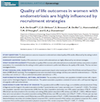Quality of life outcomes in women with endometriosis are highly influenced by recruitment strategies
It is universally accepted that endometriosis has an impact on quality of life [1,2], as well as a personal and societal cost [3], but does the disease affect all women with endometriosis equally?
 Most studies on quality of life in women with endometriosis are conducted in tertiary care centres (that may have a special interest in treating endometriosis) or within a patient association’s membership base.
Most studies on quality of life in women with endometriosis are conducted in tertiary care centres (that may have a special interest in treating endometriosis) or within a patient association’s membership base.
A research group set out to investigate whether the setting, in which patient recruitment is performed, influences the quality of life results.
Different recruitment strategies = different results
In this retrospective questionnaire-based cohort study, which was a part of the World Endometriosis Research Foundation’s EndoCost study, the research group investigated to what extent endometriosis-related quality of life outcomes are influenced by the setting in which patient recruitment is performed.
Participants were recruited in three different settings:
- a tertiary care centre for endometriosis (n=135)
- five secondary care centres (n=63)
- an endometriosis patient association (n=291)
Key findings
The results, which have been published in Human Reproduction [4], clearly indicated that quality of life outcomes in women with endometriosis are highly influenced by recruitment strategies:
- Delay of diagnosis was significantly longer in the patient association (median 7 years) than in the hospital populations (tertiary care 2 years; secondary care 1.5 years) (P<0.001).
- Tertiary care patients underwent the most invasive surgical treatments.
- One or more laparotomies was reported by 64% if the women in the tertiary care population, compared with 43% in the secondary care, and 27% the patient association (P=0.002).
- Tertiary care patients and members of the patient association scored similarly on current symptoms, effect on daily life, and effect on quality of life.
- Affected job was reported by 64% of the women in the patient association and 56% in the tertiary care population, versus 35% in the secondary care population (P<0.001).
- Chronic pain was reported by 61% of the women in the patient association and by 64% of the women in the tertiary care populations, versus 44% in the secondary care population (P=0.009).
- Affected relationships were most prevalent in the patient association setting (52%) (tertiary care 38%; secondary care 22%) (P<0.001).
- Secondary care patients had less surgical and hormone treatments, less symptoms, and a lower disease burden. In fact, they reported to have an almost normal quality of life.

Dr Aisha De Graaff, Maastricht University Hospital, The Netherlands
Said lead author, Dr Aisha De Graaff:
None of the groups appeared to be a representative selection of the total population of women with endometriosis.
An alternative strategy for creating a representative population for cost and quality of life studies is probably to recruit women who live in a specific geographic area rather than women that visit a specific hospital or are a member of a patient association.
References
- Nnoaham KE, et al. Impact of endometriosis on quality of life and work productivity: a multicenter study across ten countries. Fertil Steril 2011;96(2):366-373
- De Graaff, et al. The significant effect of endometriosis on physical, mental and social wellbeing: results from an international cross-sectional survey. Hum Reprod 2013;28(10):2677-85
- Simoens S, et al. The burden of endometriosis: costs and quality of life of women with endometriosis and treated in referral centres. Hum Reprod 2012;27:1292-9
- De Graaff, et al. Quality of life outcomes in women with endometriosis are highly influenced by recruitment strategies. Hum Reprod 2015;30(6):1331-41






